Technology Blossoms in Virginia
Putting Everything in its Place
Lab Exceeds United Way Goal of $30,000
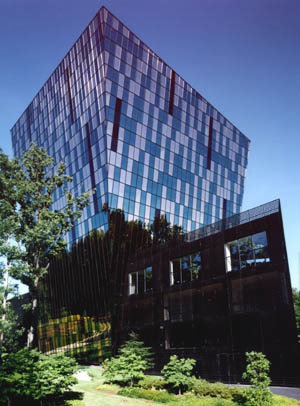
Technology Blossoms in Virginia
CIT funding helps Lab, local universities
by James Schultz
Amateur gardeners thrill to the sight of a healthy sprout. Properly attended, a fledgling flowers to adulthood, adding to the grace and beauty of a backyard landscape.
For Jefferson Lab, a long-standing collaboration with Virginia's Center for Innovative Technology (CIT) has likewise led to the robust maturation of two major projects and collaboration on several more.
In particular, says JLab technology transfer manager Fred Dylla, CIT provided start-up and other monies to the Free Electron Laser (FEL) project, and has been a vocal supporter of, and funder to, the Applied Research Center. Dylla estimates that an initial, aggregate infusion of $600,000 of CIT funds has resulted in an approximate return to the Lab of $50 million in terms of infrastructure and equipment.
"For us, it has been an essential relationship," Dylla attests. "I don't know where else we would have gone for the FEL seed money. And I believe that because of the FEL, the ARC building is here."
CIT was created in 1984 by Virginia's General Assembly as a non-profit organization designed to enhance the research and development capability of the state's major research universities. In its first decade of operation, CIT fostered relationships between the universities and state-based businesses. Ten years later, in 1994, CIT adopted a new mission, one that measured the agency's success in terms of technology-related companies and jobs created and retained. In the past four years, CIT has helped create nearly 10,000 new jobs and more than 220 new companies within the Commonwealth.
Although the Center's relationship with JLab dates back to CIT's founding, the partnership gathered steam in 1990 with the FEL proposal. Other projects followed. In 1994, joint memoranda of understanding were signed that allowed CIT to seek marketing licenses for JLab-developed intellectual property. As part of that agreement, the Laboratory agreed to keep CIT apprised of the potential marketability of any current and future research.
"From its inception, CIT has been a champion of concentrated intellectual talent," says CIT president Robert Templin, Jr. "It is the fountain from which innovation springs. In the new economy, innovation is the competitive advantage. Jefferson Lab is one of the crown jewels within the array of technology resources around the Commonwealth."
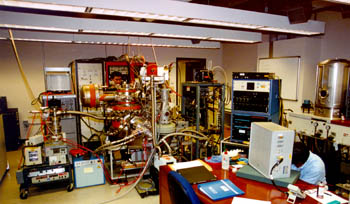
Laboratory as Jobs Generator
Encouraged by congressional legislation and subsequent government regulations that make public-private partnerships easier to initiate and maintain, the nation's federal laboratories have been undertaking ways to accelerate the transfer of technology from workbench to marketplace.
"Many people have traditionally seen federal labs as the 900-pound gorilla," says Karen Jackson, Tidewater Region director for CIT. "The labs have become much more approachable and flexible in accommodating different projects with companies. We consider all the federal labs as partners in everything we do. Our goal is to draw out in-house expertise and match it with the companies we have."
For technology startups, CIT offers assistance with feasibility studies, business plans, access to capital and manufacturing assistance. The agency also advises high-tech entrepreneurs on developing short- and long-range plans. The Lab and CIT view the Applied Research Center as one venture that will attract its share of entrepreneurs. Over the next five years, CIT will contribute a total of $2 million to ARC's Plasma and Photon Processing Center, one of the agency's select Technology Innovation Centers.
"Locally, we can't ask for a better situation than the Applied Research Center," Jackson says. "It's an excellent regional platform for the universities and JLab. We're starting to pull all the main players together. It's wonderful."
CIT's Templin, a past president of Thomas Nelson Community College, has a personal interest in the Lab dating back to the years he spent in Hampton. Templin praises Lab Director Hermann Grunder for his community outreach and aggressive support of education. It is Grunder who Templin credits for inspiring him to seek the CIT presidency.
In his current capacity, Templin has watched approvingly as Jefferson Lab has grown and achieved. He believes the kind of relationship CIT and the Lab have developed is a prototype that can be applied elsewhere in the state.
"Jefferson Lab has been a sterling success," Templin asserts. "By virtue of our collaboration here, people nationally and abroad can see the value of the application of knowledge. My hope is that, modeled after the relationship CIT and the Lab have, Virginia can incubate other centers of excellence around other emerging technologies."
Physics Well Done
Part Three: Meticulous preparation yields scientific feast!
by James Schultz
Banquet guests care little for the backstage details of the food they enjoy. A meal is judged simply, with a from-the-plate-to-the-tongue evaluation of aroma, temperature, texture and taste. But every great meal involves hours of careful planning and execution.
It's much the same with the final phase of physics experiments. Researchers must ensure that their own meticulous preparation leads to a kind of scientific feast that can be enjoyed for years after a given investigation concludes.
But as with any gala, glitches can, and do, occur. At Jefferson Lab, experimental outcomes can be adversely affected by variations in accelerator beam energy, minuscule beam-to-target offsets, changeable densities of the target itself, or problems with the complex array of detectors that track the subatomic debris generated by the collision between target and beam. That's why, says Hall C staff scientist Rolf Ent, teams put their experiments through several trial runs before recording the data they will ultimately analyze.
"You can't afford to have something go wrong hardware-wise," Ent explains. "You can lose a significant percentage of your data. So we measure something old before measuring something new. That way we make sure the beam and targets are functioning properly."
Because all three experimental halls are now routinely taking data, the Lab is handling unprecedented amounts of digitized information. All experimental results are funneled to the Lab's Computer Center and recorded on magnetic tape cassettes that can be accessed upon demand. To date, the Center has handled 40-plus terabytes of information the rough equivalent of 40 million 300-page books. "You want to completely understand every different, little part of your data. You want to make sure the data make sense," Ent points out. Then you go further; you begin interpreting the data in terms of basic physics.
Completely analyzing experimental results is a process that can take up to two years. Ent says the time spent depends on the experiment's degree of difficulty and the experience of the analyzers, a number of whom are usually graduate students or post-doctoral graduates. "Sometimes you're trying to find something very, very small. You're fishing for something very rare. Other times you're looking for something very big. Either way, if you're finished in half a year, it's exceptional."
Toward a New Physics
Some people believe that, as the millennium draws to an end, most major scientific discoveries have been made. What science remains is therefore simply a matter of filling in details. Most physicists, however, dispute this view. JLab chief scientist and Theory Group head Nathan Isgur believes many gaps remain in researchers' understanding of Nature's fundamental workings.
"Why is the nucleus made of protons and neutrons? Where does the force that holds the nucleus together come from?" Isgur asks. "Nuclear physics is still a black box. What we're doing at JLab is opening up the black box and figuring out what's inside and how what's inside works."
A deeper understanding of the physical makeup of the world usually brings practical benefits. Just as in the late 20th century society is still profiting from the development of a theory of electromagnetism from the 19th century, 100 years hence our descendants may be using technologies derived from research into the basic structure of the atomic nucleus.
"Our job is to find the right equations to describe at least that part of Nature we're observing," Isgur says. "When we find them the equations for electromagnetism, for example understanding starts pouring out. That which is unconnected is connected."
There is no guarantee that every experiment will lead to satisfying results. For experimentalists and theorists alike, sitting down together at the physics equivalent of a banquet table to view a given investigation's outcome may raise more questions than it answers. Other, more rigorous studies may be required to address new issues. Yet on certain rare occasions, the details of Nature's grand plan can be suddenly revealed, advancing understanding in one sudden, startling leap.
"An experiment doesn't always end up the way you plan," Ent points out. "Sometimes you find things you weren't expecting. That's the best thing that can happen. It gives you a new insight into physics. That's very exciting."
Editor's note: If you have or know of a website that could be informative or useful to Jefferson Lab staff, call the public affairs office at ext. 7689 or e-mail Linda Ware (ware@jlab.org).
This month's bright spot on the web takes us inside NASA the National Aeronautics and Space Administration. Warm up the computer and speed down the Internet to: shuttle.nasa.gov for the latest information on the return of shuttle mission STS-95 and its payload (experiments). Get an update on space shuttle Discovery's crew, including Senator John Glenn, 77, the world's oldest astronaut.
From the main page you can access video footage, photos and sound bites from the mission, find out about aging and space, get the latest on the international space station, or even ask an astronaut a question.
Oktoberfest '98
Lab staff turns out for music, food, costumes, games!
It looked like rain October 3 - overcast skies and sprinkles tried to doom the afternoon's festivities. But an emerging front of ghosts, goblins and other hilarious characters scared away the rain for Jefferson Lab's first Oktoberfest.
The Jefferson Lab Activities Group (JAG) hosted the event in the field behind the Residence Facility for Lab employees, family members and users.
Food, music, games and contests kept everyone busy throughout the afternoon. As in years past, the Halloween costume contest was a visual treat. For those few hours the Lab found itself home to the popular Hercules and Gabrielle, Winnie the Pooh's sidekick Eore, farm twins, Mother Nature, Indian princesses, a tooth fairy (complete with real dental jewelry), a court jester, a leprechaun, a beekeeper (complete with bees) and a variety of heavenly angels, McDonald's food items, sorcerers, fortune tellers and witches!
Winning Grand Ghoul (best overall costume) was John Hansknecht dressed as a blue-tinged steward from the ill-fated Titanic. Magnificent Monster (most original) went to Dave Kausch making a fashion statement as road kill. Dave Sideman won the Mummy Award (most unidentifiable) as Cousin It. Cynthia Sloane's Devil Biker Babe outfit took Spookiest honors, and Silliest costume went to Fred Dylla sporting the mad professor look.
Hot German sausages (grilled by a team of hard-working volunteers), sauerkraut and German potatoes warmed even the coolest ghouls as the sun bowed into the west.
Several rousing rounds of pumpkin hurling kept the crowd pumped up. Joe Beaufait and Phil Adderley took first and second, respectively, for their long distance throws. Bill Kozma earned Messiest Throw, Pam Turk made the Most Comical Throw while John Carlton earned Wimpiest Throw and Claus Rode got the Skunk Award.
The "Trouble Makers" showed off their brawn and teamwork in the Tug-O-War pull-off. Winning hands down was team captain Randy Hartman, Tom Eden, Bill Gunning, Mark Taylor, Tom Lincoln and Jennifer Daknis.
JAG chair, Dave Williams, was very happy with the turn out for the event. "I think everyone had a great time," he said afterward. A special thanks goes to Shannan Kyte and Dave Kausch (as the Oktoberfest subcommittee) for all the planning and leg work they did preparing for this event. I also want to thank Kelly Hanifan for all her work on the games. They did a tremendous job and we owe the success of our Oktoberfest to them and all of our great volunteers.
 |
 |
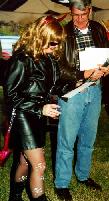 |
 |
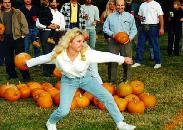 |
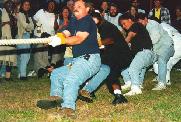 |
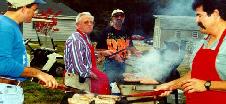 |
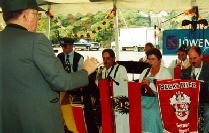 |
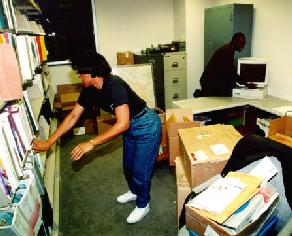
Putting Everything in its Right Place
Library moves to ARC, expands services to Lab, scientific community
Library staff are happy to announce they've completed the move to the first floor of the Applied Research Center.
The new Library features nearly 6,000 square feet of space with expanded reading and study carrel areas. In addition to more space, the new library has 350 new books available in its new Reserve Book Room, and three new computers for patron accessibility to the Library's databases and to enhance on-line searches.
The Library staff has also added two new subscriptions from the Government Research Center to supplement their electronic resources: Energy Science & Technology, and National Technical Information Services.
"Stop by and take the time to browse the library's new additions; we think you will like what you see," said Laura Brown, Lab Librarian.
The Library's main collection is located in its new space in the ARC. The Library holds 263 periodical titles of which 68 are current subscriptions. Up to three months of 16 selected current periodical titles are maintained on the second-floor atrium reading area of CEBAF Center. Current and bound periodicals are arranged alphabetically.
Preprint literature is one of the most widely used modes for the exchange and dissemination of physics research information. Preprints are obtained through exchange agreements with issuing physics research institutions. The Library's preprint collection is shelved in the open stacks of the main Library. The JLab Library currently receives preprints from more than 30 physics research institutions.
For the convenience of patrons, the Library staff has installed a book return drop box in CEBAF Center, across the atrium from the front desk.
The Library is staffed Monday through Friday, 8 a.m. to 5 p.m. Staff includes Elois Morgan, Library Manager; Laura Brown, Lab Librarian, and Carol James, administrative support. The Library is available for use by the surrounding scientific and educational community (outside patrons) during business hours. However, JLab staff and users have access to the Library 24 hours-a-day. After-hours book sign-out and return is available for in-house patrons.
An expanded description of Library services and publications is available on the web at www.jlab.org/lab.html (then click on Library).
A corner of the new facility is being dedicated to the Human Resources and Services Department and is a convenient information source for in-house patrons.

Dennis Barnes steps down as SURA President
During the Southeastern Universities Research Association (SURA) Board of Trustees meeting, Nov. 5, Dennis Barnes announced he was stepping down as SURA President at the end of calendar year 1998.
The current Chairman of the Board of Trustees, Jerry Draayer, Louisiana State University (LSU), was elected as Barnes' successor effective Jan. 1, 1999.
In his address to the trustees, Barnes cited the significant progress and growth that has occurred in SURA since the beginning of his tenure in 1992, and said SURA is now poised for new challenges in the years ahead. Although he will be pursuing other interests, Barnes will continue his involvement with the SURA information technology activities he spearheaded and he will assist the new SURA President as Draayer's term begins.
Jerry Draayer is a professor of Computer Science and Physics at LSU where he has been employed since 1975. Dr. Draayer has served on the SURA Board of Trustees since 1985 and is currently the Chair, and has served as the Chair of the New Projects Committee. From 1991 to 1993, Dr. Draayer served on the SURA Contract Negotiation Team, helping to win the performance-based contract awarded by the Department of Energy to SURA for the management and operation of Jefferson Lab. Dr. Draayer has been active in the governing of LSU during his tenure by serving as Chair of the Department of Physics and as Vice President of the Faculty Senate.
In addition, he is the Associate Commissioner of R&D for the Louisiana Board of Regents. His main research interest is the mathematical modeling of nuclear structure for heavy nuclei and he has authored more than 100 refereed papers.
JAG plans Lab youth, adult holiday parties
December is nearly upon us and with it the Lab's annual adult and children's holiday parties. The Children's Holiday Festival Around the World is set for Saturday, December 5 from 1 - 3 p.m. on the first floor of CEBAF Center. Highlights of the event include a visit from Santa Claus, children's holiday games from several countries, prizes and snacks.
Everyone attending is asked to bring an unwrapped child's toy or clothing gift for Toys for Tots, and a snack to share.
The Marines annual Toys for Tots drive is underway; collection boxes are in place around the Lab. Even if you're not planning to attend the children's event, you are welcome to donate a toy or clothing. All donations will be presented to a Toys for Tots representative during the children's party.
Adult Party
Dust off your party clothes and get ready for an evening of fun! This year's adult party will be Saturday, December 12 at the Chamberlin Hotel on Fort Monroe in Hampton. It will run from 7 p.m. 1 a.m. and feature a full dinner buffet, music and door prizes. The buffet will include chicken, ham, turkey, lasagna and a variety of salads, vegetables and desserts.
Most of the party tab is being picked up with recreation funds, so tickets for the event are only $5 per person. Tickets are limited to two per employee so you should expect the 300 tickets to go quickly. Call Dave Williams, ext. 7183; Shannan Kyte, ext. 7337; Kelly Hanifan, ext. 7668, Ruben Pedroza, ext. 7984, or stop by the CEBAF Center front desk to get your tickets today.
Reduced-rate rooms ($49/couple for the night) are available at the Chamberlin. Call 723-6511 and tell the hotel you'll be attending the JLab party when making your reservations.

The main entrance has a new sign that matches the signs already in place at the corner of Hofstadter Road and Jefferson Avenue and at the corner of Cannon Boulevard and Oyster Point Road. The sign was developed at the request of the City of Newport News to help with the marketing effort of the new Jefferson Center for Research and Technology.
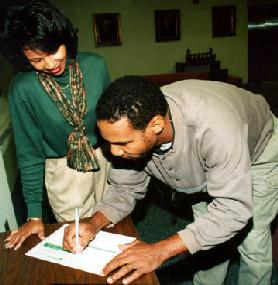
Lab Exceeds United Way Goal of $30,000
Once again, the United Way of Virginia called upon Jefferson Lab employees to help "Build a Caring Community" during its annual appeal, October 12-26.
And once again the Lab met the United Way's call for help. "With the outstanding support and generosity of Lab staff we exceeded our goal," said campaign coordinator Shilda Williams. The Lab's goal was $30,000 and contributions totaled $32,391.
In addition to the annual appeal, 11 Jefferson Lab employees participated in the United Way's "Day of Caring" on September 10. Betty Beeler, Debbie Bruhwel, Brian Carpenter, Isiah Daniels, Rick Gonzales, Denise Leary, Kisha Owens, Christine Snetter, Jerry Stokes, Ivy Thomas and Shilda Williams volunteered their time to work with United Way agencies. Volunteer projects ranged from serving meals to seniors, and replacing electrical and plumbing fixtures to painting and gardening.
Employees can support the United Way in many capacities. Volunteering time to one of the 52 agencies under the United Way umbrella is an excellent opportunity to learn about the programs and services offered. Providing financial support is another way to give back to the community and help those less fortunate than ourselves, Williams explained. One of the easiest ways to give is through payroll deduction which allows for an equal amount of money to be deducted from each paycheck.
To thank employees for their participation, gift certificates from local businesses were raffled off. Karen Bennett, Administration, won a $35 gift certificate for the Outback Steakhouse; Joyce Miller, Physics, won a $25 gift certificate to Dillard's Department Store and Carl Salmons, Physics, won three movie passes to Regal Cinemas.

